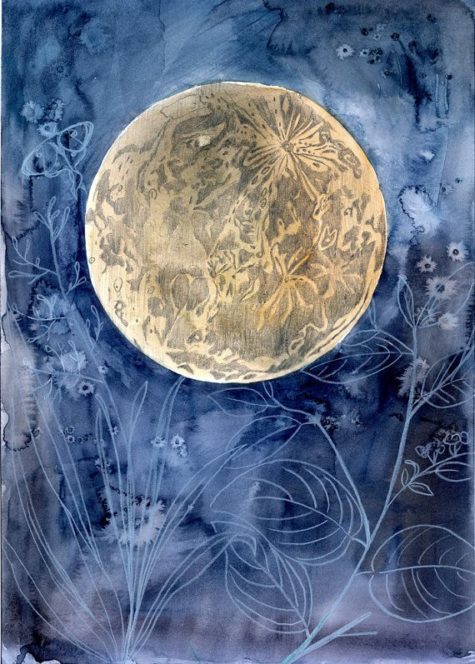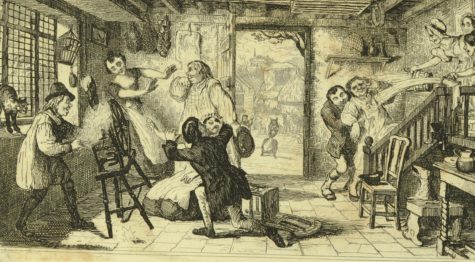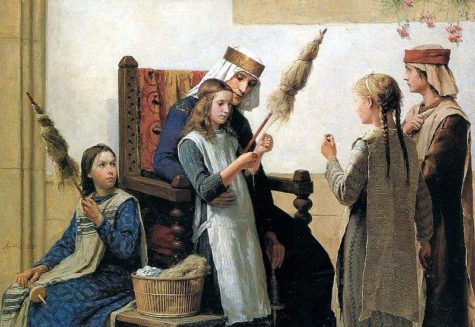Folklore
The full moon in February is known as the Quickening moon, it marks the official end of winter, and the quickening, the renewal of all things. While the skies are still gray, and the weather is cold, beneath the surface life begins to secretly stir.
This moon phase is a time of abundance, ripening and completeness, heavy with fertility and female divinity. It is a time when the potential of all things begins to stir towards birth in spring, a time to work on our own inner power and confront personal truths in preparation for birth. This moon sheds enough light to help us see into our darkness, so that our energy can make its way to the surface to prepare for growth and healing.
This is the season of Imbolc, the days when we know that if we can just hold on for a few more weeks, we might get lucky and see little green shoots peeking out through the snow and slush.
Correspondences:
- Colors: Purple and blue
- Gemstones: Rose quartz, amethyst, jasper
- Trees: Rowan, Myrtle
- Gods: Brighid, Aphrodite, Juno, Mars
- Herbs: Hyssop, sage, myrrh
- Element: Fire
The word Quickening is also used to describe the first moment in pregnancy when a woman feels the movements of her baby. So too, this a time when new life is beginning, but still lies dormant. Pregnant animals, due in the spring, begin to feel the quickening of their unborn young. The earth itself is quickening, as seeds and bulbs far beneath the soil begin their journey towards the light. We know these things are coming — and we know also that this is a good month to make plans for the future. We can dream and hope, and set goals for ourselves. Accept responsibility for mistakes you’ve made in the past, and move on.
Magical workings this month should focus on personal achievements and advancement. This is an excellent time for fertility and childbirth spells.
From various sources
 January 25 is St. Paul’s day, a festival of the Roman and English churches in commemoration of St. Paul. This day is thought to be prophetic as to the weather of the year:
January 25 is St. Paul’s day, a festival of the Roman and English churches in commemoration of St. Paul. This day is thought to be prophetic as to the weather of the year:
“If St. Paul’s day be fair and clear, It doth betide a happy year; If blustering winds do blow aloft. Then wars will trouble our realm full oft; And if it chance to snow or rain, Then will be dear all sorts of grain.”
In Germany when the day proved foul the common people used to drag the images of St. Paul and St. Urban in disgrace to duck them in the river.
- On the day of the conversion of St . Paul, (January 25th,) the four winds wrestle and the winner will blow most of the year. (Belgium.)
- If it rains on St. Paul’s day there will be plenty of mushrooms. (Bohemia.)
Other omens and folklore for St Paul’s day include the following:
- Fire will not burn a man born on St . Paul’s day, but if a woman who was born on that day is burned, the wound will never heal.
- Interestingly, in Sicily, it doesn’t matter what day you were born on – if you are a man fire will not burn you, but if you are a woman it will not only burn, it will eventually cause your death!
On a more positive note:
- If you set your hens to hatch on Paul’s day, they will become good layers.
Found in: Encyclopedia of superstitions, folklore, and the occult
 There are two feast days in the year which are dedicated to St Peter. January 16, and June 29 (which is the feast of Saints Peter and Paul). What follows is lore and superstition surrounding St Peter’s day:
There are two feast days in the year which are dedicated to St Peter. January 16, and June 29 (which is the feast of Saints Peter and Paul). What follows is lore and superstition surrounding St Peter’s day:
- No building should ever be begun on St . Peter’s day. It will never prosper.
- The Wallachians say that on St. Peter’s day all roads are guarded by serpents, and whoever kills one on that day will be lucky all the year.
- If it rains on St. Peter and St. Paul, there will be plenty of mushrooms.
- If you set your hens to hatch on Peter’s and Paul’s day, they will become good layers.
- Make nests for the hens on St . Peter’s day, And many ‘s the egg that they will lay.
Collected from various sources
 In Sweden, January 13, St Knut’s Day, is the traditional day to discard the Christmas tree and end the season’s festivities. A children’s party is the favored way to strip the tree of its decorations, after which the children are free to “plunder” the edible treats and small gifts placed on the tree especially for the occasion.
In Sweden, January 13, St Knut’s Day, is the traditional day to discard the Christmas tree and end the season’s festivities. A children’s party is the favored way to strip the tree of its decorations, after which the children are free to “plunder” the edible treats and small gifts placed on the tree especially for the occasion.
This Christmas tree plundering is often accompanied by smashing up the gingerbread houses and eating them while discarding of the decorations. Finally, everyone “dances” the tree out the door. Singing special songs, they pick up the tree and toss it out into the snow.
However in Finland, the tradition is quite different:
Called Nuutinpäivä, there has been a tradition somewhat analogous to modern Santa Claus, where young men dressed as a goat (Finnish: Nuuttipukki) would visit houses. Usually the dress was an inverted fur jacket, a leather or birch bark mask, and horns. Unlike Santa Claus, Nuuttipukki was a scary character.
The men dressed as Nuuttipukki wandered from house to house, came in, and typically demanded food from the household and especially leftover alcoholic beverages. In Finland the Nuuttipukki tradition is still living at areas of Satakunta, Southwest Finland and Ostrobothnia. However, nowadays the character is usually played by children and now involves a happy encounter.
A proverb from Noormarkku says:
Hyvä Tuomas joulun tua,
paha Knuuti poijes viä
“Good Thomas brings Christmas,
evil Knut takes it away.”
Courtesy of: almanac.com and Wikipedia
 Tonight is the night of the Wolf Moon. This first full moon of the new year is a time of silence and sitting by the home fire. As the wild winter howls, appreciate the warmth of home and family.
Tonight is the night of the Wolf Moon. This first full moon of the new year is a time of silence and sitting by the home fire. As the wild winter howls, appreciate the warmth of home and family.
Now is the time to go within and plan the changes you will make in the spring. Consider now what you will plant. Start a moon journal to record your lunar tides and write down your spring dreams.
Correspondences:
- Colors: Black and white, silver
- Gemstones: Hematite
- Trees: Birch, Hazel
- Gods: Inanna, Freyja
- Herbs: Thistle, nuts and seeds, marjoram
- Element: Air
Full Moon names started with Native Americans as tribes kept track of the seasons by giving distinctive names to each recurring full Moon. The names actually applied to the entire month in which each occurred. There was some variation in the names based on tribes. European settlers followed that custom and created some of their own names.
Sometimes it is also referred to as the Cold Moon, Old Moon, or the Moon After Yule. Some called it the Full Snow Moon, but Wolf Moon seems most appropriate, in native cultures, because amid the cold and deep snows of midwinter, the wolf packs howled hungrily outside their small villages, huts, and teepees. Since the lunar month is only 29 days long on the average, the full Moon dates shift from year to year.
This is a good time to work on magic related to protection, both physical and spiritual. Use this time to develop your inner self, and advance spiritually, becoming closer to the higher aspects of your deities.
More about the Full Wolf Moon
It’s been a tough month for some of us. I thought it fitting to toss out some symbolic observations about the January Wolf Moon with a goal to offer inspiration to folks facing some challenges right now.
- Lunar Symbolism:
Before blasting off into Wolf Moon symbolism, let’s take a look at lunar implications. Subtle, cunning and soft in silky shadows, the moons meanings can be slippery. But, to those who grasp moon symbolism, great insights follow. Typically feminine in archetypal understanding, the moon carries themes of cycles and fertility.
Moreover, the moon conveys a kind of creativity that is born from veiled magic. Consider the moon’s growth cycles (waxing, full, waning, new). These phases are wrought from the moon’s movement. And, the manifestation of her development is made known to us through light and shadow.
What’s the symbolic lesson here? Progress is sometimes subtle. Manifestations of evolution often occur behind the scenes, in shadow – before we “see the light” or the end-product of our vision.
When contemplating this month’s full moon and its partnership with the Wolf, we must not cram our intellect into the void. Rather, the Wolf Moon asks us to use intuitive instinct in soft ways.
The gifts of this full moon come to our senses like steam rising over sacred waters marbled with frosty stillness.
Wolf Symbolism and Wolf Moon Solutions:
Strategic, resourceful and incredibly communicative, the Wolf is a noble mentor for humankind. Wolves have specific protocol and rank within their packs. This observation is a cue to look to community for creative solutions during this full moon. Communicate with those in your pack to help you with your challenges. But don’t break taboo. If you follow specific traditions in social communication, hold to them. In fact, use this full moon to honor traditions of your heritage. Take time to honor your elders too. Tribal rituals should be heeded this time of year.
Wolves are vastly expressive. Sure, their vocalizations (baling, howling and barking) are legendary, but Wolves also have an complex system of body language and even eye contact to convey intent and current state of being. Discipline in the pack is rarely corporeal. Rather, behavior is admonished or reinforced by intricate expressions. One look from the Alpha can convey as much power as a physical blow.
There’s big medicine in this. Use this full moon to get in touch with your own modes of expression. Explore your own eye contact and body language. Examine yourself in the mirror (yes, I’m serious) as you’re talking on the phone. View yourself objectively. What are your expressions conveying? How can you modify or enhance your body language to portray more authority or power? Or, perhaps more softness and sensuality is needed. Too often we are unconscious about our eye and body movements in the scheme of social interaction. This is a great time to ponder these nuances of communication.
Wolves are also phenomenally resourceful. In fact, their resourcefulness is partly why this moon carries the Wolf moniker. January is a brutal month in the northern regions. The frigidity of winter crunches life to a stand-still in the wild. To be sure, it’s a time of “sink or swim” to all wildlife exposed to the elements this time of year.
Wolves, however, often thrive during this lean month. They are designed to handle the brutality of cold quite well. Furthermore, as Wolves are inclined to pick off weaker animals, January offers up a host of feasting options. Perhaps we can use the resourcefulness of the Wolf to reconsider our options in life. Maybe what seems bleak or lame in our life is actually an invitation for opportunity. Food for thought.
I hope these symbolic ideas about the cold Wolf Moon inspire you to take advantage of January’s lunar fullness. Take a pause on the evening of this month’s full moon to contemplate your own inner wisdom too. I bet your findings will be illuminating.
~collected from various sources, including Symbolic Meanings
It’s Distaff’s Day (Jan 7th) and time to get back to work after the holidays. (According to Old English tradition, that is.) A distaff is the wooden rod (staff) that holds the flax or wool on a spinning wheel. The term distaff came to refer to both women’s work and the female branch (distaff side) of the family. The women’s husbands did not go back to work until the following Monday (see below), so they would mischievously try to set fire to the flax on their wives’ distaffs, while the women, lying in wait, would douse them with buckets of water.
From Chambers Book of Days, we have this explanation:
As the first free day after the twelve by which Christmas was formerly celebrated, the 7th of January was a notable one among our ancestors. They jocularly called it St. Distaff’s Dag, or Rock Dag, because by women the rock or distaff was then resumed, or proposed to be so. The duty seems to have been considered a dubious one, and when it was complied with, the ploughmen, who on their part scarcely felt called upon on this day to resume work, made it their sport to set the flax a-burning; in requital of which prank, the maids soused the men from the water-pails.
“Partly work and partly play.
Ye must on Saint Distaff’s day;
From the plough soon free the team,
Then come home and fother them;
If the maid a spinning goe,
Burn the flax and fire the towe,
Bring in pails of water then
Let the maids bewash the menne;
Give Saint Distaff all the right
Then bid Christmas sports good-night,
And next morrow every one.
To his own vocation.”
This is an excellent day for spells involving sewing, weaving, mending, and also for practical jokes and family fun.
A Ritual for St Distaff Day:
From the book, 365 Goddess, we have some nice ideas for how to celebrate St. Distaff day in a magickal way:
- Themes: Work, Weaving, Destiny
- Symbols: Web, Spinning Wheel, Needle
Presiding Goddess:
Arachne, the Greek spider goddess, inspires positive changes in your destiny for the new year. Legend tells us that Arachne challenged Athena to a weaving contest and won. In anger, Athena destroyed the girl’s tapestry. Arachne, grief-stricken, took her destiny in hand and turned herself into a spider, but she continues to use her weaving talents to spin and pattern the lives of mortals.
To do today:
According to lore, Saint Distaff, the patroness of weaving, was a fictional persona made up to mark the resumption of normal activity after the holidays. Instead of this imaginary figure, we turn to Arachne to help us take the strands of our fate in hand and begin weaving a year filled with goddess energy.
To direct your spiritual focus toward the goddess, wear something woven today, or display it proudly. If you have no such items, braid together three strands of thread or yarn, saying:
Arachne, bless this magic braid,
so on you my mind is staid.
Carry this as a charm to keep your thoughts and actions goddess-centered.
Finally, mend any work clothes in need or repairs to improve your job standing. As you make the final knot in a button or hem, bind the magic by saying:
This thread I wind,
The magic bind.
Visualize your professional goals as you work.
More about St. Distaff Day:
St. Distaff’s Day had no connection whatsoever with any saint but its place in the folk calendar gives an indicator of the importance of spinning at a time when this was the only means of turning the raw wool, cotton or flax into thread capable of being woven into cloth.
The day, which was also known as Rock Day (referring to another name for either the distaff or the spindle) indicated that this was the end of the Christmas festivities and the return to the normality of spinning whenever there was a spare moment.
As Anthony Fitzherbert, wrote in his ‘Boke of Husbandrie’ (1523):
it saveth a woman from being idle,
and the product was needful’.
Before the invention of the Spinning Wheel, spinning on what is known as the Drop Spindle (a pin or stick weighted by a whorl) was a slow and tedious task. The spinning of one pound of woolen yarn could take about one week and one pound of heavy cotton yarn several weeks to spin.
The method had not changed since the earliest times. There are images from as far back as time of the Ancient Egyptians showing how the distaff was used to hang the flax or tow and the spindle to effect the twisting. The distaff was carried under the arm, and the spindle left dangling and turning in the fingers below, and forming an axis round which to wind parcels of the thread as soon as it was made.
Women of all classes would spin. Everyone from the Lady to the peasant was expected to spend time on the task, though the wealthier may have elaborate spindles. In the evening, after the chores of the day were done, there would be spinning, and the spindle would be taken to visit friends as the task could be undertaken at the same time as a conversation.
Source: Telling History
What follows is a list (in alphabetical order) of the names given to the January moon. Also listed is the tradition and/or origin of that moon name:
- Avunniviayuk ~Inuit
- Big Cold Moon ~Mohawk
- Chaste Moon ~other
- Cold Meal Moon ~Natchez
- Cold Moon ~Cheokee
- Cooking Moon ~Choctaw
- Dark Moon ~Janic
- Disting Moon ~other
- Flying Ant Moon ~Apache
- Great Spirit Moon ~Anishnaabe
- Her Cold Moon ~Wishram
- Ice Moon ~San Juan, Neo-Pagan
- Icicle Moon ~Medicine Wheel
- Joyful Moon ~Hopi
- Little Winter Moon ~Creek
- Man Moon ~Taos
- Moon After Yule ~Cherokee
- Old Moon –Algonquin
- Quiet Moon ~Celtic, Janic
- Snow Moon ~other
- Storm Moon ~other
- Strong Cold Moon ~Sioux, Cheyenne
- Whirling Wind Moon ~Passamaquoddy
- Winter Moon ~Algonquin
- Wolf Moon ~Medieval English, Janic










